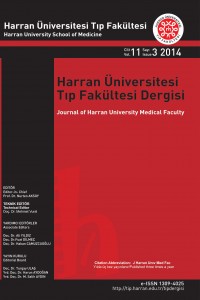Öz
Sir,
Transversus abdominis plane (TAP) block is a relatively new regional anesthesia technique in which T7-12
intercostal nerves, ilioinguinal and iliohypogastric nerves, and cutaneous branches of L1-3 nerves are
blocked between the internal oblique and transversus abdominis muscles (1). Mostly this technique has been
used for postoperative analgesia in patients undergoing abdominal wall surgery (2).
A 75 years old male referred to our anesthesiology department with a pain after concerning postoperative
hernia repair.Based on his medical history the pain began after 3 months of unilateral hernia repair.When the
patient was referred to our clinic his VAS score was 8/10 and the pain interfered with mobilization and
breathing. The pain was especially most intense on T8-10 dermatomes and did not subside with nonsteroidal
anti-inflammatory drugs, paracetamol and peroral tramadol. So that a TAB catheter replacement was planned
for the patient.
18 G thuogy needle was placed under ultrasound guidance until it entered the transversus abdominis plane.
After the spread of local anesthetic injection via the plane a catheter was placed. Each day 20 ml
levobupivacaine was injected for two days. At the end of the second day the patient reported that the pain was
ended and his VAS score was 1/10. Post procedural control period after 10 days and one month, the patient
reported no pain with VAS score 0-1. Also we added pregabalin for neuropatic pain 1 week after the insertion
of the catheter.
Articles have described that ultrasound guided TAP block reduces pain scores and opioid consumption in
early postoperative period (2,3), but there is not enough data about chronic pain management. So; this
approach would be helpful for chronic pains due to postoperative abdominal wall surgery.
Anahtar Kelimeler
Kaynakça
- 1) Tran TMN, Ivanusic JJ, Hebbard P, Barrington MJ. Determination of spread of injectate after ultrasoundguided transversus abdominis plane block: A cadaveric study. Br J Anaesth 2009;102:123-7. 2) McDonnell JG, O'Donnell B, Curley G, Heffernan A, Power C, Laffey JG. The analgesic efficacy of transversus abdominis plane block after abdominal surgery: a prospective randomized controlled trial. Anesth Analg 2007;104(1):193-7. 3) McDonnell JG, Curley G, Carney J, Benton A, Costello J, Maharaj CH, et al. The analgesic efficacy of transversus abdominis plane block after cesarean delivery: a r a n d omi z e d c o n tr o ll e d tri a l. An e st h An a l g 2008;106(1):186-91.
Öz
Sir,
Transversus abdominis plane (TAP) block is a relatively new regional anesthesia technique in which T7-12
intercostal nerves, ilioinguinal and iliohypogastric nerves, and cutaneous branches of L1-3 nerves are
blocked between the internal oblique and transversus abdominis muscles (1). Mostly this technique has been
used for postoperative analgesia in patients undergoing abdominal wall surgery (2).
A 75 years old male referred to our anesthesiology department with a pain after concerning postoperative
hernia repair.Based on his medical history the pain began after 3 months of unilateral hernia repair.When the
patient was referred to our clinic his VAS score was 8/10 and the pain interfered with mobilization and
breathing. The pain was especially most intense on T8-10 dermatomes and did not subside with nonsteroidal
anti-inflammatory drugs, paracetamol and peroral tramadol. So that a TAB catheter replacement was planned
for the patient.
18 G thuogy needle was placed under ultrasound guidance until it entered the transversus abdominis plane.
After the spread of local anesthetic injection via the plane a catheter was placed. Each day 20 ml
levobupivacaine was injected for two days. At the end of the second day the patient reported that the pain was
ended and his VAS score was 1/10. Post procedural control period after 10 days and one month, the patient
reported no pain with VAS score 0-1. Also we added pregabalin for neuropatic pain 1 week after the insertion
of the catheter.
Articles have described that ultrasound guided TAP block reduces pain scores and opioid consumption in
early postoperative period (2,3), but there is not enough data about chronic pain management. So; this
approach would be helpful for chronic pains due to postoperative abdominal wall surgery.
Anahtar Kelimeler
Kaynakça
- 1) Tran TMN, Ivanusic JJ, Hebbard P, Barrington MJ. Determination of spread of injectate after ultrasoundguided transversus abdominis plane block: A cadaveric study. Br J Anaesth 2009;102:123-7. 2) McDonnell JG, O'Donnell B, Curley G, Heffernan A, Power C, Laffey JG. The analgesic efficacy of transversus abdominis plane block after abdominal surgery: a prospective randomized controlled trial. Anesth Analg 2007;104(1):193-7. 3) McDonnell JG, Curley G, Carney J, Benton A, Costello J, Maharaj CH, et al. The analgesic efficacy of transversus abdominis plane block after cesarean delivery: a r a n d omi z e d c o n tr o ll e d tri a l. An e st h An a l g 2008;106(1):186-91.
Ayrıntılar
| Birincil Dil | İngilizce |
|---|---|
| Bölüm | Editöre Mektup |
| Yazarlar | |
| Yayımlanma Tarihi | 15 Aralık 2014 |
| Gönderilme Tarihi | 7 Kasım 2013 |
| Kabul Tarihi | 2 Mayıs 2014 |
| Yayımlandığı Sayı | Yıl 2014 Cilt: 11 Sayı: 3 |
Harran Üniversitesi Tıp Fakültesi Dergisi / Journal of Harran University Medical Faculty


